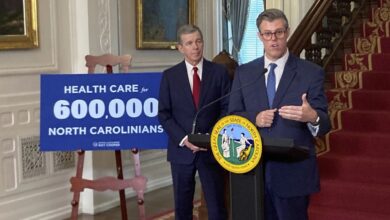As the election battle between Donald Trump and Joe Biden begins, there are growing fears around the health of the US news media which has been struck by job losses, declining circulations, the closure or crippling of well-known brands and rise of new threats such as fake or AI-generated information on social media.
Evidence of this state of crisis abounds. Last year, more than 21,400 media jobs were lost, the highest since 2020, when 16,060 cuts were recorded when print was still in the process of being succeeded by digital news distribution. Major names including the Washington Post, the Los Angeles Times and Vice have taken serious hits, alongside scores of smaller brands and the total collapse of newcomers such as the Messenger.
“We’ve settled into the final act of the election season, and it’s promising to be the harbinger of all kinds of problems because of the nature of the candidates,” says Robert Thompson at Syracuse University. At the same time, he says, “the very industry that should be girding up for this is in a total state of crisis”.
Readership and income from digital production has been falling overall, and industry downsizing in 2024 appears to be accelerating. Meanwhile, social media is uncoupling as a referral service to news organizations, which hits both readership size and revenue generation. Meta has dropped its news tab from Facebook, Google is more unpredictable, and X has de-prioritized posts that contain outside referrals.
Readers are fleeing to mediums in which fresh dangers lurk, even when accounting for the partisan nature of some US news sites. The share of US adults who say they regularly get news from TikTok has more than quadrupled, from 3% in 2020 to 14% in 2023, yet such sites are subject to the threat of viral misinformation – whether deliberately sown or spread organically.
Last week, NBC reported on a seminar in New York that gamed out what could happen if AI-created misinformation disrupts November’s presidential vote. A former Department of Homeland Security official, Miles Taylor, told NBC that it was “jarring” for attendees to see how rapidly such scenarios “could spiral out of control and really dominate the election cycle”.
Nor has an anticipated election year spike in readership – “the Trump bump” (in essence the the positive economic effects of selling negativity in the media) – materialized. Nor may it. Only about a third (35%) of US voters say they are satisfied with the people who will be running for president, according to Pew Research.
Alongside that, a decline of regional news outlets has led to what is termed “news deserts”, which are defined by UNC’s Hussman School of Journalism and Media as “a community, either rural or urban, with limited access to the sort of credible and comprehensive news and information that feeds democracy at the grassroots level”.
Last year, the loss of local newspapers accelerated to more than two per week, on average, leaving more than 200 counties local information deserts, with more than half having limited access, according to researchers at Northwestern University’s Medill School of Journalism. Studies contend that without those resources civic engagement declines.
According to Northwestern’s Penelope Abernathy, author of a series of studies on the effect of news deserts, the news ecosystem that held together a vast country is under threat.
“We’ve lost in two ways: the small local newspapers that fed up the chain, and the reporters on the larger dailies that were responsible for tying it all together. So you’re left with your cellphone, and the disproportionate amount of misinformation and disinformation that comes in,” she said.
Fragmentation and re-fragmentation of audiences, in progress since the 1996 Telecommunications Act, has led to news as a consumer choice, marketed along ideological lines, that has led to increased polarization and confirmation bias: the reward of being told what you already believe.
Jonathan Miller, a former chief digital officer at News Corp, told the FT last week: “You just want to hear what you want to hear.” Correspondingly, just 32% of Americans who say they trust the mass media “a great deal” or “a fair amount” to report the news in a full, fair and accurate way.
“All of this is tied together by changes in the way information is delivered,” said Thompson. “That changed the way the business runs, of not having a decent business model, and that moved us into the arena of political dichotomies and specialized audiences.”
According to Thompson, the overall state of crisis in news information is perfectly illustrated by a significant – and growing – part of the population that believe that the 2020 election was rigged.
“What we’re looking at is both a business crisis and a lack of confidence,” Thompson says, as if people are concluding that the news media “doesn’t look like it’s in control of itself, so why should we believe it?”
While there is still plenty of information coming from reliable sources, he adds, “the number of people for whom that breakdown has occurred is very likely enough to determine who wins this election.”
Read More



